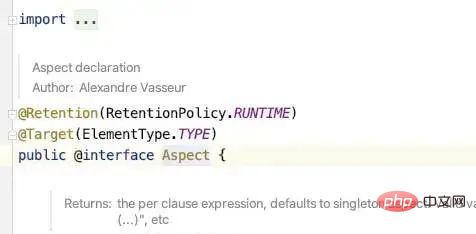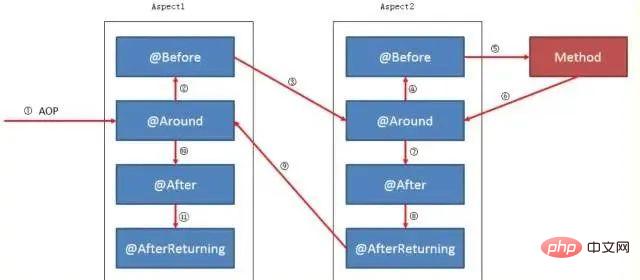Interviewer: Spring Aop common annotations and execution sequence
Recently, when I was revising resumes and doing mock interviews for many people, some friends gave me feedback on Spring AOP interview questions, and I will ask them today.
The most powerful thing about Spring at the beginning is the two core functions of IOC/AOP. Today we will learn about the common annotations and execution sequence of Spring AOP.
Spring interview core points:
IOC, AOP, Bean injection, Bean life cycle, Bean circular dependency
First of all we Let’s review some commonly used annotations in Spring Aop:
@BeforePre-notification: Execute before the target method-
@AfterPost notification: executed after the target method (always executed) @AfterReturningPost notification: execution method ends Execute before (not executed if exception occurs)@AfterThrowingException notification: Execute after exception@AroundAround notification: Around target method execution
##FAQ
1. You must know Spring. Let’s talk about the order of all notifications of Aop. How does Spring Boot or Spring Boot 2 affect the execution order of aop? 2. Tell us about the pitfalls you encountered in AOP?Sample code
Let’s quickly build a demo program of spring aop to discuss spring together Some details in aop.
Configuration file
For the convenience, I directly use spring-boot for quick projects To build, you can use the spring-boot project quick creation function of idea, or go to start.spring.io to quickly create a spring-boot application.
Because I often manually post some dependencies on the Internet, there are some problems such as dependency conflicts and service startup failure.
plugins {
id 'org.springframework.boot' version '2.6.3'
id 'io.spring.dependency-management' version '1.0.11.RELEASE'
id 'java'
}
group 'io.zhengsh'
version '1.0-SNAPSHOT'
repositories {
mavenCentral()
maven { url 'https://repo.spring.io/milestone' }
maven { url 'https://repo.spring.io/snapshot' }
}
dependencies {
# 其实这里也可以不增加 web 配置,为了试验简单,大家请忽略
implementation 'org.springframework.boot:spring-boot-starter-web'
implementation 'org.springframework.boot:spring-boot-starter-actuator'
implementation 'org.springframework.boot:spring-boot-starter-aop'
testImplementation 'org.springframework.boot:spring-boot-starter-test'
}
tasks.named('test') {
useJUnitPlatform()
}Interface class
First we need to define an interface. Here we can review the choice of JDK's default proxy implementation:
If the target object implements the interface, the JDK dynamic proxy is used by default If the target object does not implement the interface, use dynamic proxy If the target object implements the interface and Cglib is forced, use cglib proxy
The logic of this piece is in DefaultAopProxyFactory If you are interested, you can take a look.
public interface CalcService {
public int div(int x, int y);
}Implementation class
Here we will simply do a division operation, which can simulate normal or easy errors.
@Service
public class CalcServiceImpl implements CalcService {
@Override
public int div(int x, int y) {
int result = x / y;
System.out.println("====> CalcServiceImpl 被调用了,我们的计算结果是:" + result);
return result;
}
}aop interceptor
#To declare an interceptor, we need to add @Aspect and @Component to the current object. The author has only stepped on it before. Only one such pit has been added.
其实这块我刚开始也不是很理解,但是我看了 Aspect 注解的定义我就清楚了

这里面根本就没有 Bean 的定义。所以我们还是乖乖的加上两个注解。
还有就是如果当测试的时候需要开启Aop 的支持为配置类上增加@EnableAspectJAutoProxy 注解。
其实 Aop 使用就三个步骤:
定义 Aspect 定义切面 定义 Pointcut 就是定义我们切入点 定义具体的通知,比如: @After, @Before 等。
@Aspect
@Component
public class MyAspect {
@Pointcut("execution(* io.zhengsh.spring.service.impl..*.*(..))")
public void divPointCut() {
}
@Before("divPointCut()")
public void beforeNotify() {
System.out.println("----===>> @Before 我是前置通知");
}
@After("divPointCut")
public void afterNotify() {
System.out.println("----===>> @After 我是后置通知");
}
@AfterReturning("divPointCut")
public void afterReturningNotify() {
System.out.println("----===>> @AfterReturning 我是前置通知");
}
@AfterThrowing("divPointCut")
public void afterThrowingNotify() {
System.out.println("----===>> @AfterThrowing 我是异常通知");
}
@Around("divPointCut")
public Object around(ProceedingJoinPoint proceedingJoinPoint) throws Throwable {
Object retVal;
System.out.println("----===>> @Around 环绕通知之前 AAA");
retVal = proceedingJoinPoint.proceed();
System.out.println("----===>> @Around 环绕通知之后 BBB");
return retVal;
}
}测试类
其实我这个测试类,虽然用了 @Test 注解,但是我这个类更加像一个 main 方法把:如下所示:

执行结论
结果记录:spring 4.x, spring-boot 1.5.9
无法现在依赖,所以无法试验
我直接说一下结论:Spring 4 中环绕通知是在最里面执行的
结果记录:spring 版本5.3.15 springboot 版本2.6.3

多切面的情况
多个切面的情况下,可以通过@Order指定先后顺序,数字越小,优先级越高。如下图所示:

代理失效场景
下面一种场景会导致 aop 代理失效,因为我们在执行 a 方法的时候其实本质是执行 AServer#a 的方法拦截器(MethodInterceptor)链, 当我们在 a 方法内直接执行b(), 其实本质就相当于 this.b() , 这个时候由执行 a方法是调用到 a 的原始对象相当于是 this 调用,那么会导致 b() 方法的代理失效。这个问题也是我们开发者在开发过程中最常遇到的一个问题。
@Service
public class AService {
public void a() {
System.out.println("...... a");
b();
}
public void b() {
System.out.println("...... b");
}
}The above is the detailed content of Interviewer: Spring Aop common annotations and execution sequence. For more information, please follow other related articles on the PHP Chinese website!

Hot AI Tools

Undresser.AI Undress
AI-powered app for creating realistic nude photos

AI Clothes Remover
Online AI tool for removing clothes from photos.

Undress AI Tool
Undress images for free

Clothoff.io
AI clothes remover

Video Face Swap
Swap faces in any video effortlessly with our completely free AI face swap tool!

Hot Article

Hot Tools

Notepad++7.3.1
Easy-to-use and free code editor

SublimeText3 Chinese version
Chinese version, very easy to use

Zend Studio 13.0.1
Powerful PHP integrated development environment

Dreamweaver CS6
Visual web development tools

SublimeText3 Mac version
God-level code editing software (SublimeText3)

Hot Topics
 1653
1653
 14
14
 1413
1413
 52
52
 1304
1304
 25
25
 1251
1251
 29
29
 1224
1224
 24
24
 Break or return from Java 8 stream forEach?
Feb 07, 2025 pm 12:09 PM
Break or return from Java 8 stream forEach?
Feb 07, 2025 pm 12:09 PM
Java 8 introduces the Stream API, providing a powerful and expressive way to process data collections. However, a common question when using Stream is: How to break or return from a forEach operation? Traditional loops allow for early interruption or return, but Stream's forEach method does not directly support this method. This article will explain the reasons and explore alternative methods for implementing premature termination in Stream processing systems. Further reading: Java Stream API improvements Understand Stream forEach The forEach method is a terminal operation that performs one operation on each element in the Stream. Its design intention is
 PHP: A Key Language for Web Development
Apr 13, 2025 am 12:08 AM
PHP: A Key Language for Web Development
Apr 13, 2025 am 12:08 AM
PHP is a scripting language widely used on the server side, especially suitable for web development. 1.PHP can embed HTML, process HTTP requests and responses, and supports a variety of databases. 2.PHP is used to generate dynamic web content, process form data, access databases, etc., with strong community support and open source resources. 3. PHP is an interpreted language, and the execution process includes lexical analysis, grammatical analysis, compilation and execution. 4.PHP can be combined with MySQL for advanced applications such as user registration systems. 5. When debugging PHP, you can use functions such as error_reporting() and var_dump(). 6. Optimize PHP code to use caching mechanisms, optimize database queries and use built-in functions. 7
 PHP vs. Python: Understanding the Differences
Apr 11, 2025 am 12:15 AM
PHP vs. Python: Understanding the Differences
Apr 11, 2025 am 12:15 AM
PHP and Python each have their own advantages, and the choice should be based on project requirements. 1.PHP is suitable for web development, with simple syntax and high execution efficiency. 2. Python is suitable for data science and machine learning, with concise syntax and rich libraries.
 PHP vs. Other Languages: A Comparison
Apr 13, 2025 am 12:19 AM
PHP vs. Other Languages: A Comparison
Apr 13, 2025 am 12:19 AM
PHP is suitable for web development, especially in rapid development and processing dynamic content, but is not good at data science and enterprise-level applications. Compared with Python, PHP has more advantages in web development, but is not as good as Python in the field of data science; compared with Java, PHP performs worse in enterprise-level applications, but is more flexible in web development; compared with JavaScript, PHP is more concise in back-end development, but is not as good as JavaScript in front-end development.
 PHP vs. Python: Core Features and Functionality
Apr 13, 2025 am 12:16 AM
PHP vs. Python: Core Features and Functionality
Apr 13, 2025 am 12:16 AM
PHP and Python each have their own advantages and are suitable for different scenarios. 1.PHP is suitable for web development and provides built-in web servers and rich function libraries. 2. Python is suitable for data science and machine learning, with concise syntax and a powerful standard library. When choosing, it should be decided based on project requirements.
 Java Program to Find the Volume of Capsule
Feb 07, 2025 am 11:37 AM
Java Program to Find the Volume of Capsule
Feb 07, 2025 am 11:37 AM
Capsules are three-dimensional geometric figures, composed of a cylinder and a hemisphere at both ends. The volume of the capsule can be calculated by adding the volume of the cylinder and the volume of the hemisphere at both ends. This tutorial will discuss how to calculate the volume of a given capsule in Java using different methods. Capsule volume formula The formula for capsule volume is as follows: Capsule volume = Cylindrical volume Volume Two hemisphere volume in, r: The radius of the hemisphere. h: The height of the cylinder (excluding the hemisphere). Example 1 enter Radius = 5 units Height = 10 units Output Volume = 1570.8 cubic units explain Calculate volume using formula: Volume = π × r2 × h (4
 PHP: The Foundation of Many Websites
Apr 13, 2025 am 12:07 AM
PHP: The Foundation of Many Websites
Apr 13, 2025 am 12:07 AM
The reasons why PHP is the preferred technology stack for many websites include its ease of use, strong community support, and widespread use. 1) Easy to learn and use, suitable for beginners. 2) Have a huge developer community and rich resources. 3) Widely used in WordPress, Drupal and other platforms. 4) Integrate tightly with web servers to simplify development deployment.
 PHP's Impact: Web Development and Beyond
Apr 18, 2025 am 12:10 AM
PHP's Impact: Web Development and Beyond
Apr 18, 2025 am 12:10 AM
PHPhassignificantlyimpactedwebdevelopmentandextendsbeyondit.1)ItpowersmajorplatformslikeWordPressandexcelsindatabaseinteractions.2)PHP'sadaptabilityallowsittoscaleforlargeapplicationsusingframeworkslikeLaravel.3)Beyondweb,PHPisusedincommand-linescrip




